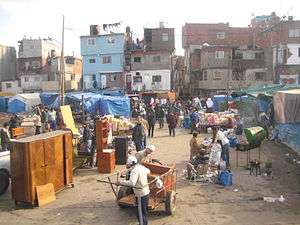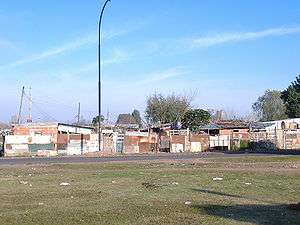Villa miseria


A villa miseria (Spanish pronunciation: [ˈbiʎa miˈseɾja], locally: [ˈbiʒa ~ ˈbiʃa ...]), or just villa, is a type of shanty town or slum found in Argentina, mostly around the largest urban settlements. The term is a noun phrase made up of the Spanish words villa (village, small town) and miseria (misery, dejection), and was adopted from Bernardo Verbitsky's 1957 novel Villa Miseria también es América ("Villa Miseria is also [a part of] the Americas").
These settlements consist of small houses or shacks made of tin, wood and other scrap material. Generally, the streets are not paved and narrow internal passages connect the different parts. The villas miseria have no sanitation system, though there may be water pipes passing through the settlement. Electric power is sometimes taken directly from the grid using illegal connections, which are perforce accepted by suppliers.
The villas range from small groups of precarious houses to larger, more organized communities with thousands of residents. In rural areas, the houses in the villas miserias might be made of mud and wood. Villas miseria are found around and inside the large cities of Buenos Aires, Rosario, Córdoba and Mendoza, among others. The villas draw people from several backgrounds. Some are local citizens who have fallen from an already precarious economic position. In most cases, a villa miseria is populated by the children and grandchildren of the original settlers, who have been unable to improve their economic status.
Villas miseria are known to house criminals, from minor thieves to drug dealers, because the houses are typically safe from police and they are really cheap and easy to acquire.
These shantytowns are euphemistically called asentamientos ("settlements") or villas de emergencia ("emergency villages"). In most parts of Argentina, the non-modified word villa usually refers to a villa miseria.
Argentinian painter Antonio Berni dealt with the hardships of living in a villa miseria through his series Juanito Laguna, a slum child, and Ramona Montiel, a prostitute.
The Argentinian writer Hugo Pezzini, in his book, The Latin American Literature of the Neoliberal Crisis: The Emergence of a Postmodern Post-hegemonic Heterotopy (Amsterdam: Universiteit van Amsterdam - Cultural Analysis Summer Academy, 2013), commenting on writer César Aira's 2001 novel La Villa says the following: "The apparent absurdity of César Aira's novel La Villa provides an instance of resourceful mediation to semantically reorganize a situation of emergency and locate it within its particular rationale. In Argentina, a slum is popularly called 'villa miseria,' or simply 'la villa.' In politically correct language, that is, officially, is called 'villa de emergencia.'” The slum of Aria's La Villa is an organized-organic post-hegemonic microcosm whose symbols and rational design are only understood by its post-hegemonic inhabitants, who are also its architects and engineers. To them their semantics are perfectly logical and knowable."
Statistics and programs
.jpg)
According to July 2004 estimates, there are about 640 "precarious neighborhoods" in suburban Buenos Aires, comprising 690,000 residents and 111,000 households. The population of the villas miseria in the city of Buenos Aires doubled during the 1990s, reaching about 120,000 as of 2005.
Attempting to address this problem, de facto President Alejandro Lanusse established the National Housing Fund (FONAVI) in 1972. An amalgam of long-standing national housing programs and lending facilities previously managed by the National Mortgage Bank, the FONAVI helped coordinate slum clearance efforts and, since then, has put up over 25,000 housing units a year (both single-family and multi-family types).[1]
Granting deeds on a lease-to-own basis, the fund mostly provides for households in Argentina's lowest income bracket and, thus, has historically had a collection rate of less than five per cent. The fund, one of the most important in Latin America, is largely underwritten by national fuel and other excise taxes.[1]
See also
| Wikimedia Commons has media related to Villa miseria. |
- Favela
- Pueblos jóvenes
- Cantegril
- Barrios
- Colonia (border settlement)
- Poverty
- Argentine economic crisis (1999–2002)
- Economy of Argentina
References
External links
- (Spanish) El derecho a la vivienda en Argentina, Informe misión de investigación, Centre of Housing Rights and Evictions, 2004.